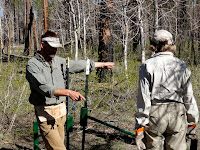and a person for work that is real.”
Marge Piercy
This summer hundreds of GCT volunteers are burning hundreds of thousands of calories to protect and restore the Colorado Plateau. Every single day in the field our volunteers give their time to work long hours doing extremely physical work and make it so much fun! The Volunteer Program staff is constantly fulfilled and uplifted by the spirit volunteers bring to both work and camp life.

Volunteer projects on the Kane and Two Mile ranches ranged from monitoring invasive cheatgrass to building a dozen long term exclosures to study the potential impacts of both bison and cattle on the ecosystems of the Kaibab Plateau. These science-based projects will provide land managers with the tools for management practices in the future. In Utah volunteers are covering lots of ground on the Aquarius Plateau, to assess the upper reaches of the famed Escalante Watershed to assess potential habitat that would support the reintroduction of beavers. Several groups of youth from area reservations and as far away as the East Coast are keeping the legacy of traditional agriculture alive at North Leupp Family Farms on the Navajo Reservation. These young volunteers helped plant over 4 acres of desert-adapted heirloom seeds.

Together we are building a community of smart and committed land stewards dedicated to the future of the Colorado Plateau. This sentiment is best reflected by a comment from a recent volunteer: “My experience with Lauren and Joshua and others on the trip has rekindled my hope that there are too many of us kindred spirits to allow the short-sightedness of man to destroy the world we so love.”
There are many upcoming opportunities with Colorado Plateau springs as a spring steward volunteer. Check out our trip schedule to get in on the action!








 Last year our volunteers donated over 14,000 hours of their time in the field and office. We are, once again, adding those hours up and celebrating the amazing work done thus far in just the five months of field time in 2010. Thank you for partnering with the Grand Canyon Trust. Your generosity of time and energy has already contributed to:
Last year our volunteers donated over 14,000 hours of their time in the field and office. We are, once again, adding those hours up and celebrating the amazing work done thus far in just the five months of field time in 2010. Thank you for partnering with the Grand Canyon Trust. Your generosity of time and energy has already contributed to:

 Here's to a year of exploration, restoration, and conservation of our treasured Colorado Plateau.
Here's to a year of exploration, restoration, and conservation of our treasured Colorado Plateau.










